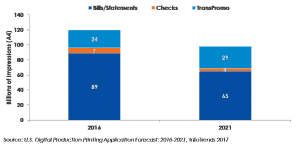High-Speed Inkjet Trends: Consumers Still Want Print in 2018
Home / High-Speed Inkjet Trends: Consumers Still Want Print in 2018
This is a guest article from Canon Solutions America.
Consumers are bombarded with thousands of promotional messages every day, including television and radio ads, direct mail, out-of-home advertising, social media, email, and digital banner ads. Today’s marketers are challenged with getting their messages out in a way that cuts through this clutter and encourages desired behaviors in recipients. which might include simply recognizing a brand or purchasing a new product or service. Statements and other transactional documents are increasingly being leveraged as a marketing platform, so they are becoming an integral part of the overall customer experience. When used properly, a statement can stimulate desirable customer behaviors and minimize undesirable actions.  Transactional documents can be used to cross-sell products and services, alleviate customer concerns, increase loyalty, and maintain confidence, particularly in tumultuous markets and times of corporate malfeasance.
Transactional documents can be used to cross-sell products and services, alleviate customer concerns, increase loyalty, and maintain confidence, particularly in tumultuous markets and times of corporate malfeasance.
Savvy marketers are seeking more relevant, variable, personalized marketing messaging, and high-speed inkjet printing technology has become a primary contender to meet this growing demand. Inkjet technology is taking hold, providing organizations with more choices for addressing high-volume transactional and direct mail applications, and offering an affordable alternative to pre-printed color shells. These new developments make it possible to produce full-color variable data and images, even in instances where personalized information was historically limited to monochrome text.
The commercialization and implementation of inkjet printing is enabling the production of affordable full-color work and personalization with faster turnaround times. Moving forward, ongoing innovations in inkjet will drive substantial growth in digital page volumes. InfoTrends estimates that inkjet devices produced more than 122 billion impressions in the United States in 2016, and that number is predicted to reach 246 billion impressions by 2021 — a 14.9% CAGR (Compound Annual Growth Rate).
Figure 1: U.S. Annual Inkjet Impressions: 2016-2021

In its most recent U.S. Application Forecast, Keypoint Intelligence – InfoTrends shares the largest applications by page volume in 2016 and their growth through 2021. All of the top applications account for more than 10 billion impressions in 2016. By 2021, the top three applications will be books, direct mail, and bills/statements. Their combined volumes are expected to reach about 286 billion impressions.
Figure 2: Application Overview – Transactional Communications

There is no denying the importance of color in business communications – the movement toward more color in basic bill/statement printing due to the affordability of digital color inkjet technology, but the use of color increases brand recognition and improves response rates. By blending transaction data and full-color customer-specific messages into sophisticated communications, transactional documents like bills, statements, and purchase orders can be transformed into attention-grabbing marketing tools that reinforce branding and promote a dialogue with customers to cross-sell and up-sell products and services. Adding unique calls-to-action on top of all of this will help marketers drive response rates on direct mailpieces.
Transactional printing is the original variable data printing application. Each bill, statement, invoice, check, or explanation of benefits has content that is unique to the recipient. Research suggests that businesses’ expectations for paperless delivery always exceed actual growth. Despite efforts to move customers away from paper-based communications, consumers still value physical documents. Americans received more than 26.3 billion bills and statements in 2016.[1] According to InfoTrends’ 2017 Annual State of Transactional Communications Survey, only 34% of bills and statements were “paperless” this year.
Over 88% of the 2,000 consumers that responded to InfoTrends’ survey are still receiving some paper versions of their transactional communications. The top reasons for retaining paper statements included:
- Wanting a hard copy for records (47%)
- They serve as a reminder to pay (37%)
- As a security precaution (23%)
While banks, credit card companies, and other businesses are aggressively pushing consumers to receive their monthly statements electronically, research is showing that many consumers simply aren’t ready. Rather than going completely paperless, consider enhancing your printed communications. Based on InfoTrends’ research, businesses can improve the value of their communications in the following ways:
- Make them relevant to the recipient
- Make them easier to understand
- Personalize the content
- Put multiple communications in a single envelope
- Use color to emphasize important information
Service providers must understand their clients’ customers and their communication preferences. You need to help clients cater to the needs of the individual, whether it is paper, paperless, or a combination of both. Today’s market is more complex than ever before and multi-channel communications that incorporate print will remain important for consumers of all ages.
The availability of high-volume white paper color printing technology combined with a high level of dynamic personalization and multi-channel deployment gives marketing departments access to one of the most powerful promotional tools. Transaction documents are being delivered to consumers every day—enriching them with marketing content makes good business sense in an environment where consumers are seeking better, more colorful, and more personalized/relevant communications.
Simply put, high-speed inkjet and full color communications are providing value to marketers and service providers alike. Success in 2018 requires delivering enhanced communications through affordable digital color and the associated improvements in response rates, time-to-market, and reduced call center traffic. For high-volume producers, this is becoming an operational imperative for overall cost reduction.
[1] The Household Diary Study, USPS 2016

